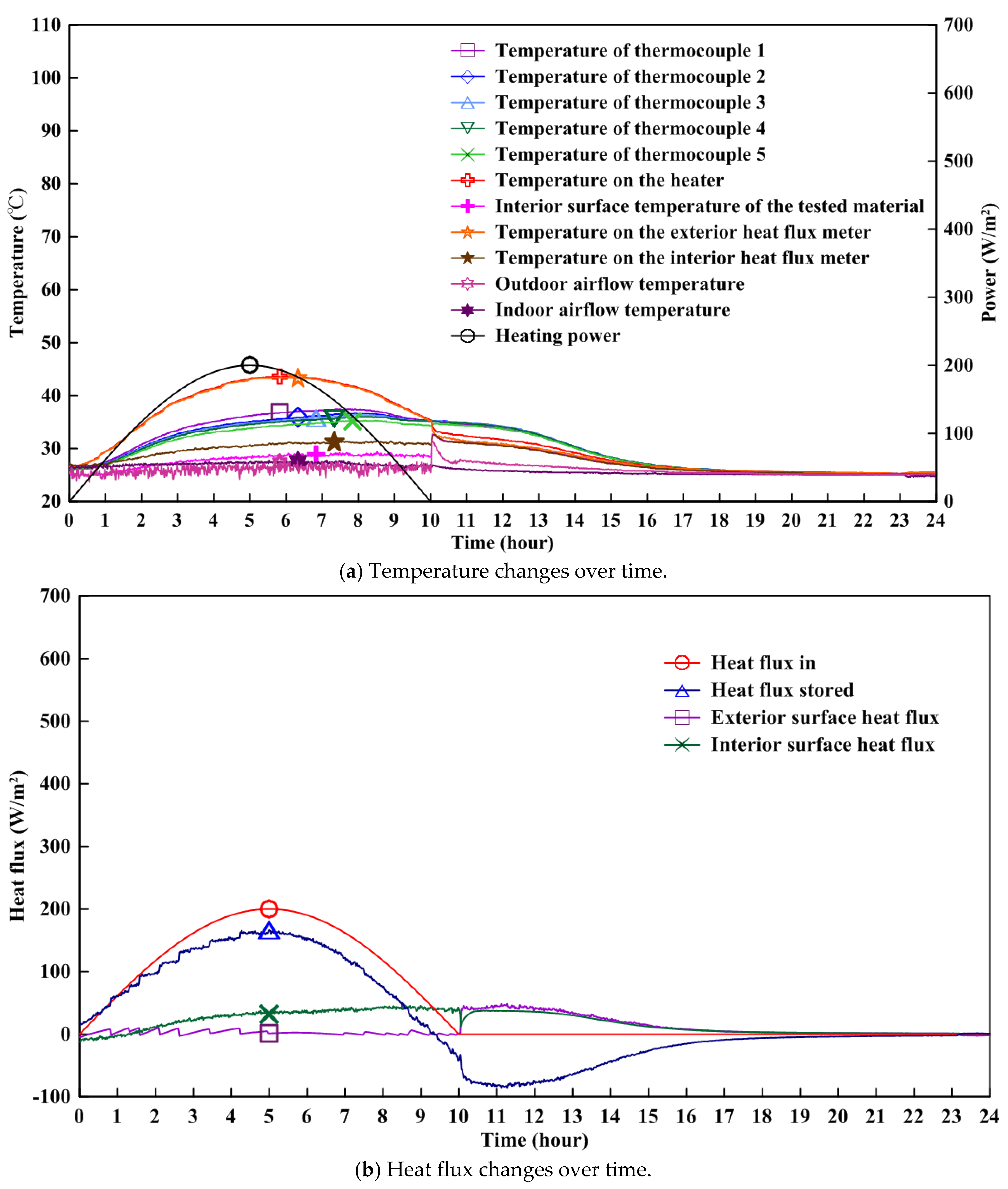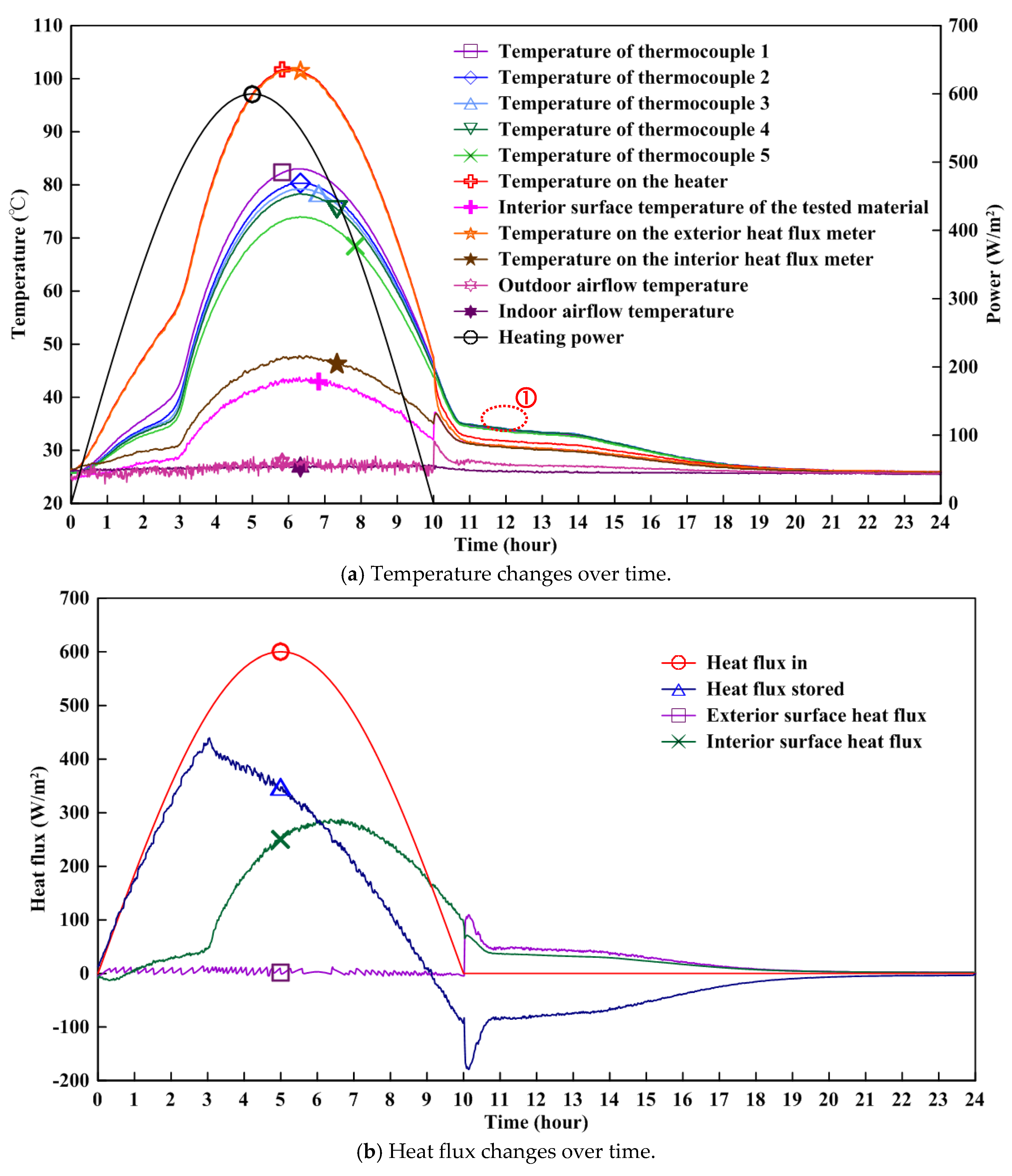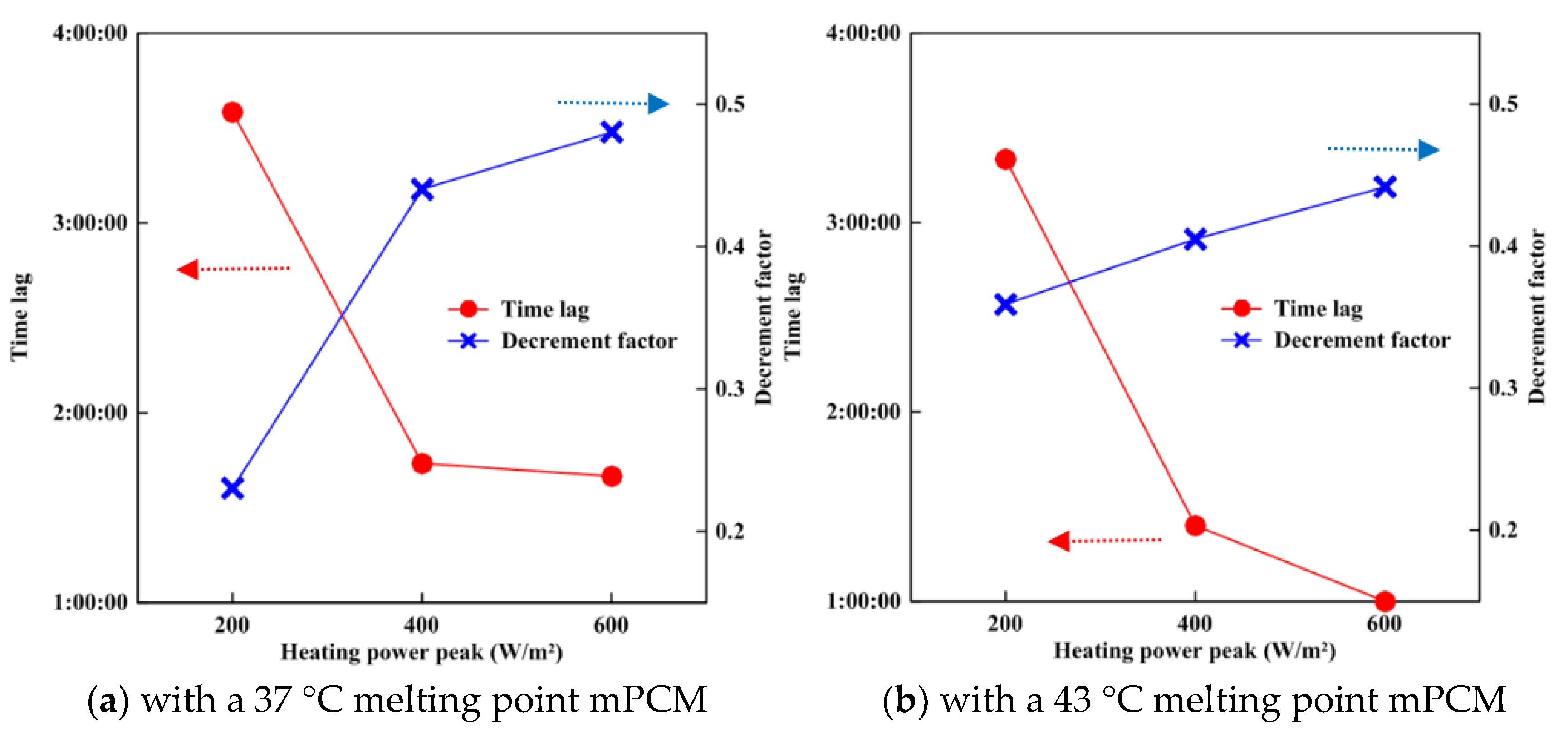Thermal Performance of Microencapsulated Phase Change Material (mPCM) in Roof Modules during Daily Operation
Abstract
:1. Introduction
2. Research Methods
2.1. Tested Roof Module
2.2. The mPCM Capsule
2.3. Experimental Procedure
2.4. Experimental Uncertainty
3. Results and Discussion
3.1. Case Studies
 in Figure 3a) continuously decreased. The indoor air-conditioning was turned off in the experiment to reflect a lack of air-conditioning in the off-work hours, which caused the module’s indoor side surface temperature (denoted by the symbol + in Figure 3a) to increase slightly at the beginning and then slowly decrease. The indoor heat flux through the module (denoted by the symbol x in Figure 3a) decreased slightly, followed by a rapid increase, and then a slow decrease again. In the early stages of nighttime cooling, due to the above boundary condition change, both the temperature and the heat flux values underwent large changes and entered the smooth natural cooling stage after approximately 30 min (when the experiment time was 10.5 h). The temperature and heat flux at all points decreased gradually. At roughly the sixth hour of nighttime cooling (when the experiment time reached 16 h and the actual time was approximately 23:00), the temperature and heat flux at all points recovered to their initial states.
in Figure 3a) continuously decreased. The indoor air-conditioning was turned off in the experiment to reflect a lack of air-conditioning in the off-work hours, which caused the module’s indoor side surface temperature (denoted by the symbol + in Figure 3a) to increase slightly at the beginning and then slowly decrease. The indoor heat flux through the module (denoted by the symbol x in Figure 3a) decreased slightly, followed by a rapid increase, and then a slow decrease again. In the early stages of nighttime cooling, due to the above boundary condition change, both the temperature and the heat flux values underwent large changes and entered the smooth natural cooling stage after approximately 30 min (when the experiment time was 10.5 h). The temperature and heat flux at all points decreased gradually. At roughly the sixth hour of nighttime cooling (when the experiment time reached 16 h and the actual time was approximately 23:00), the temperature and heat flux at all points recovered to their initial states. in Figure 4a, is 0.43.
in Figure 4a, is 0.43.3.2. Findings
4. Conclusions
- When the tested mPCM roof modules were at a high solar heat gain (600 W/m2), the decrement factor of the heat flux of the 37 °C melting point module was 0.48, which was slightly higher than the value of 0.44 for the 43 °C melting point module, indicating that the 37 °C melting point module has a higher peak indoor heat gain (approximately 4% higher). However, the time lag of the heat flux of the 37 °C melting point module was 100 min, which was far greater than the 60 min of the 43 °C melting point module, indicating that the 37 °C melting point module has the better peak load shifting ability.
- For the conditions of daytime heating and nighttime natural convection cooling established in this study, the mPCMs with 37 and 43 °C melting points inside the two roof modules are both effective at releasing their solar heat, allowing them to be restored to their initial state to begin thermal cycling again the following day.
Acknowledgments
Author Contributions
Conflicts of Interest
References
- Zhang, Y.; Zhou, G.; Lin, K.; Zhang, Q.; Di, H. Application of latent heat thermal energy storage in buildings: State-of-the-art and outlook. Build. Environ. 2007, 42, 2197–2209. [Google Scholar] [CrossRef]
- Kalnæs, S.E.; Jelle, B.P. Phase change materials and products for building applications: A state-of-the-art review and future research opportunities. Energy Build. 2015, 94, 150–176. [Google Scholar] [CrossRef]
- Memon, S.A. Phase change materials integrated in building walls: A state of the art review. Renew. Sustain. Energy Rev. 2014, 31, 870–906. [Google Scholar] [CrossRef]
- Konuklu, Y.; Ostry, M.; Paksoy, H.O.; Charvat, P. Review on using microencapsulated phase change materials (PCM) in building applications. Energy Build. 2015, 106, 134–155. [Google Scholar] [CrossRef]
- Akeiber, H.; Nejat, P.; Majid, M.Z.A.; Wahid, M.A.; Jomehzadeh, F.; Famileh, Z.I.; Calautit, J.K.; Hughes, B.R.; Zaki, S.A. A review on phase change material (PCM) for sustainable passive cooling in building envelopes. Renew. Sustain. Energy Rev. 2016, 60, 1470–1497. [Google Scholar] [CrossRef]
- Mohamed, S.A.; Al-Sulaiman, F.A.; Ibrahim, N.I.; Zahir, M.H.; Al-Ahmed, A.; Saidur, R.; Yılbaş, B.S.; Sahin, A.Z. A review on current status and challenges of inorganic phase change materials for thermal energy storage systems. Renew. Sustain. Energy Rev. 2017, 70, 1072–1089. [Google Scholar] [CrossRef]
- Silva, T.; Vicente, R.; Rodrigues, F.; Samagaio, A.; Cardoso, C. Development of a window shutter with phase change materials: Full scale outdoor experimental approach. Energy Build. 2015, 88, 110–121. [Google Scholar] [CrossRef]
- Lecompte, T.; Le Bideau, P.; Glouannec, P.; Nortershauser, D.; Le Masson, S. Mechanical and thermo-physical behaviour of concretes and mortars containing phase change material. Energy Build. 2015, 94, 52–60. [Google Scholar] [CrossRef]
- Zhou, T.; Darkwa, J.; Kokogiannakis, G. Thermal evaluation of laminated composite phase change material gypsum board under dynamic conditions. Renew. Energy 2015, 78, 448–456. [Google Scholar] [CrossRef]
- Wang, Q.; Zhao, C.Y. Parametric investigations of using a PCM curtain for energy efficient buildings. Energy Build. 2015, 94, 33–42. [Google Scholar] [CrossRef]
- Gracia, A.; Castell, A.; Fernández, C.; Cabeza, L.F. A simple model to predict the thermal performance of a ventilated facade with phase change materials. Energy Build. 2015, 93, 137–142. [Google Scholar] [CrossRef]
- Liu, S.; Li, Y. An experimental study on the thermal performance of a solar chimney without and with PCM. Renew. Energy 2015, 81, 338–346. [Google Scholar] [CrossRef]
- Lai, C.-M.; Chen, R.H.; Lin, C.-Y. Heat transfer and thermal storage behaviour of gypsum boards incorporating micro-encapsulated PCM. Energy Build. 2010, 42, 1259–1266. [Google Scholar] [CrossRef]
- Lai, C.-M.; Hokoi, S. Thermal performance of an aluminum honeycomb wallboard incorporating microencapsulated PCM. Energy Build. 2014, 73, 37–47. [Google Scholar] [CrossRef]
- Liu, P.-F.; Lin, Y.-P.; Tzeng, C.-T.; Lai, C.-M. Heat transfer and energy performance of a PVA wall tile containing macro-encapsulated PCM. Energies 2016, 9, 652. [Google Scholar] [CrossRef]





| Used PCM | Characteristics | 200 W/m2 | 400 W/m2 | 600 W/m2 |
|---|---|---|---|---|
| 37 °C mPCM | Temperature time lag | 303 min | 95 min | 78 min |
| Temperature decrement factor | 0.75 | 0.50 | 0.43 | |
| 43 °C mPCM | Temperature time lag | 304 min | 53 min | 53 min |
| Temperature decrement factor | 0.68 | 0.52 | 0.46 |
© 2018 by the authors. Licensee MDPI, Basel, Switzerland. This article is an open access article distributed under the terms and conditions of the Creative Commons Attribution (CC BY) license (http://creativecommons.org/licenses/by/4.0/).
Share and Cite
Zhou, Q.; Liu, P.-F.; Tzeng, C.-T.; Lai, C.-M. Thermal Performance of Microencapsulated Phase Change Material (mPCM) in Roof Modules during Daily Operation. Energies 2018, 11, 679. https://doi.org/10.3390/en11030679
Zhou Q, Liu P-F, Tzeng C-T, Lai C-M. Thermal Performance of Microencapsulated Phase Change Material (mPCM) in Roof Modules during Daily Operation. Energies. 2018; 11(3):679. https://doi.org/10.3390/en11030679
Chicago/Turabian StyleZhou, Qi, Pin-Feng Liu, Chun-Ta Tzeng, and Chi-Ming Lai. 2018. "Thermal Performance of Microencapsulated Phase Change Material (mPCM) in Roof Modules during Daily Operation" Energies 11, no. 3: 679. https://doi.org/10.3390/en11030679
APA StyleZhou, Q., Liu, P.-F., Tzeng, C.-T., & Lai, C.-M. (2018). Thermal Performance of Microencapsulated Phase Change Material (mPCM) in Roof Modules during Daily Operation. Energies, 11(3), 679. https://doi.org/10.3390/en11030679






